In this comprehensive guide, we will explore different aspects of dental crowns
Whether you are seeking a solution for a cracked tooth, a severely decayed tooth, or simply wish to improve the aesthetics of your smile, dental crowns offer a durable and aesthetically pleasing option. By providing an extra layer of protection and support, dental crowns can significantly enhance the functionality and appearance of teeth.
Throughout this article, we aim to provide valuable insights and information to help you make informed decisions about dental crowns. By understanding their benefits, the process involved, and proper maintenance, you can take the necessary steps towards achieving a healthy, beautiful smile with the help of dental crowns.
What are dental crowns?
What are dental crowns? Dental or porcelain crowns are considered a coat that covers the visible portion of the tooth. The shape of any crown is created based on its natural tooth. Unlike metal-based crowns, the advantage of porcelain crowns is an aesthetic factor as the replacement looks like the former, which is important if you get the crown for your front teeth.

Who needs a crown ?
The patients who need a dental crown are those that have:
- A tooth is severely decayed or damaged: If a tooth has a large cavity or has been weakened by a fracture or other trauma, a crown may be needed to restore the tooth’s strength and function.
- A tooth has undergone a root canal: After a root canal, a tooth may become weakened and more susceptible to fractures. A dental crown can protect the tooth and help prevent future damage.
- A tooth is severely discolored or misshapen: A dental crown can be used to cover a tooth that is severely stained or discolored, or to improve the appearance of a tooth that is misshapen or otherwise aesthetically unappealing.
- A tooth is used to anchor a dental bridge: Dental bridges are used to replace missing teeth. The teeth on either side of the gap are typically fitted with dental crowns to anchor the bridge in place.
- A dental implant is being placed: Dental implants are used to replace missing teeth. A dental crown is typically placed on top of the implant to restore the appearance and function of the missing tooth.
See more: Root canal treatment
Your dentist can evaluate your specific dental needs and recommend a dental crown if it is the best course of treatment for your particular situation.
Why are dental crowns needed?
You may want to consider a porcelain crown if you:
- Have recently suffered an injury to your tooth, to protect a weak tooth from fracture or restore a cracked, worn down tooth.
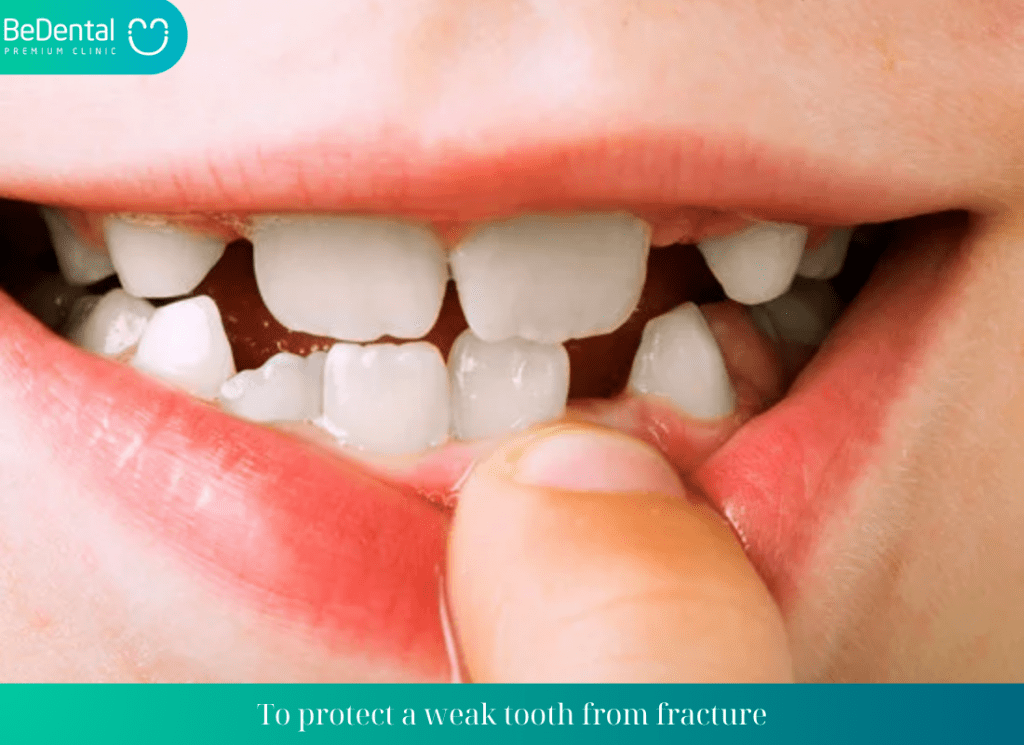
- Require an anchor for a dental bridge, to hold the dental bridge in place.
- Want to reshape a crooked tooth, to enhance your smile.
- To replace a large filling that has come loose or fallen out, to cover and support the teeth with filling.
- Have been treated with a root canal treatment.
Essentially, the role of porcelain crowns is to protect the tooth and improve the strength and durability of an existing tooth.
What is the process of porcelain crown treatment?
What is the process of porcelain crown treatment? Porcelain crown treatment usually necessitates 2 appointments. Because your tooth is prepared for the placement of the porcelain crown. On the first visit, the dentist will take X-rays of the tooth and the bone around it. You may need to have a root canal treatment if there’s any:
- Tooth decay.
- Risk of infection.
- Injury to the tooth’s pulp.
Step 1: The dentist will then identify, remove fragile parts of the tooth, and make more room for a temporary crown. And if your tooth loses too much, a filling can be used to expanse your tooth before the crown covers.
See more: Tooth decay and 11 risk factors
Step 2: After the natural tooth is ready, a paste or putty is used to make a copy of the tooth. The copies will also be made for the teeth above and below the tooth that’s getting the dental crown. The involved impressions are to ensure that the crown will not interfere with your eating.
Step 3: The impressions will reach a laboratory. The laboratory will make the crowns, and this process usually takes 2 to 3 weeks. Before the next visit, your prepared tooth will be restored with a temporary crown while you’re waiting for the permanent one.
Step 4: The second visit is usually in the next 2 weeks, your temporary crown will be removed and the permanent one will be checked. If everything is okay, the gum below your tooth will be numbed and the new crown will be fitted.
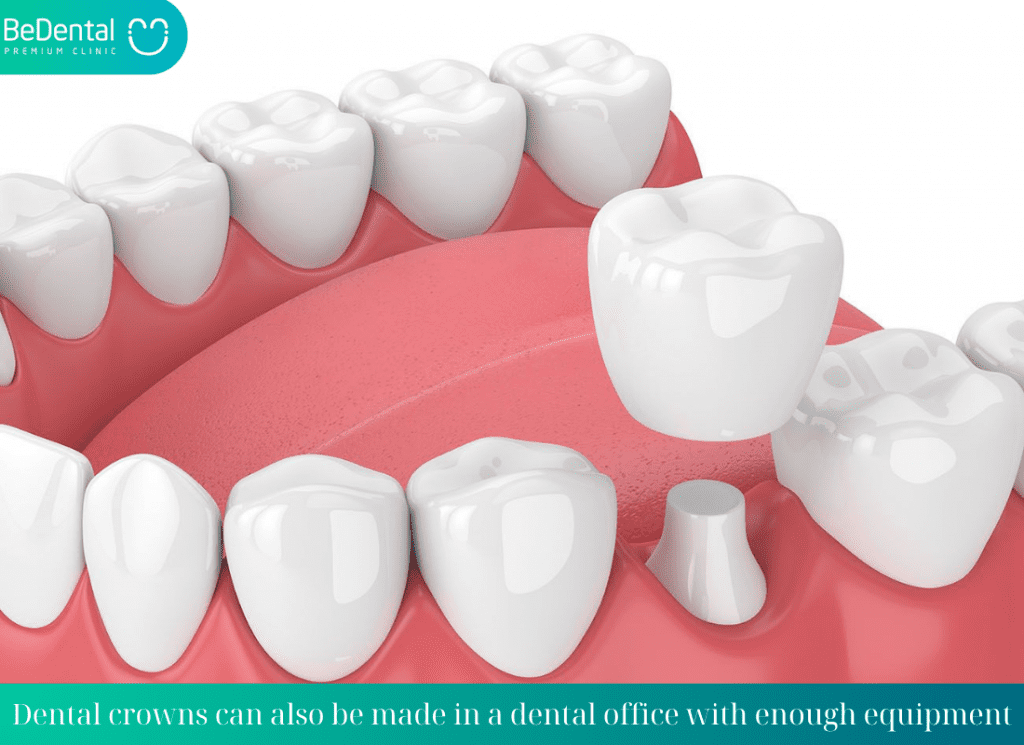
Dental crown treatment in one day. Dental crowns can also be made in a dental office if your dentist has the necessary equipment. This process is conducted similarly to the traditional way — this procedure begins with the removal of decay and shaping of the tooth to ensure an entire fit inside the crown.
Because the permanent crowns are made in a day, the next stage is different from the traditional way. A scanning device (a “wand”) is used to take digital pictures of the tooth inside your mouth.
These images are assessed by the computer’s software that builds a 3D model of the tooth. Then the digital design is delivered to a second in-office machine to cut a ceramic block into the shape of the crown. This method is called computer-aided or computer-aided manufacturing (CAD/CAM). In about 15 minutes, the crown is done to be cemented into place.
See more: Tartar and 6 ways to prevent its return
What are dental crowns made of?
Permanent crowns can be made out of many different materials. These materials can include:
- Metal: Dental crowns can be made from a variety of metals, including gold, palladium, nickel, and chromium. Metal crowns are the least likely to chip or shatter, wear down the least quickly, and only need a little portion of your tooth to be removed. The metallic color is the main drawback of this type of crown. The biggest disadvantage of this kind of crown is its metal crowns. Metal crowns are a good option for hidden molars.
- Porcelain-fused-to-metal: This kind of dental crown can be fit to the color of the natural teeth that’s next to the crown. They have a natural look. However, occasionally a black line can be seen as the metal underneath the porcelain crown top. Other drawbacks include the potential for the porcelain piece of the crown to shatter or break off and the crown wearing down the teeth next to it in the mouth. Dental crowns made of porcelain bonded to metal may be a considerable option for front or back teeth.
- All-resin: Resin-based dental crowns are often less costly than other crown types. They are more prone to crack than porcelain-fused-to-metal crowns, although they wear down over time.
- All-ceramic or all-porcelain: Compared to other crown types, these kinds of dental crowns offer the closest approximation to natural skin tone. They’re also a wise choice if you’re allergic to metal. They lack the strength of porcelain-fused-to-metal crowns. Additionally, unlike metal or resin crowns, they have the potential to damage the teeth next to them. Front teeth suit for all-ceramic crowns.
- Pressed ceramic: There is a firm inner core in these dental crowns. Pressed ceramic dental crowns replace the metal liner that’s used in the all-ceramic crown-making process. Porcelain is used to cap pressed ceramic crowns because it offers the closest natural color match. They are more long-lasting than an all-porcelain crown…
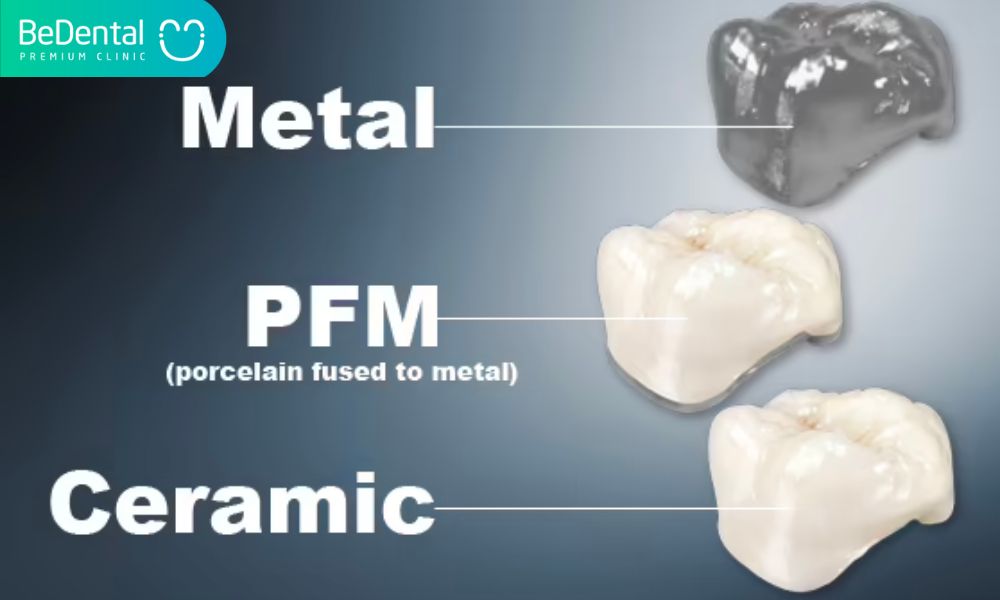
Comparison: Metal vs porcelain crowns
Metal crowns are typically made from cobalt-chromium, nickel-chromium and other metal-based alloys. Metal crowns are well-known for their durability and have been used in dentistry for a lot of years. Compared to porcelain crowns, they are the least prone to wear down over time or get chipped or broken. The majority of patients decide to have metal crowns placed on their back teeth (posterior teeth) since they are hidden.
On contract, porcelain crowns are made to resemble the natural appearance of your teeth and come in 2 main forms: all-porcelain or all-ceramic. Both are safe options for people with metal allergies and can be utilized for both front and back teeth.
What are onlays and 3/4 crowns?
You can utilize a variety of crown kinds on your teeth. Dental crowns such as onlays and 3/4 crowns don’t completely cover your teeth as standard dental crowns do. A standard crown will cover your entire tooth. When you still have a healthy tooth structure, onlays and 3/4 crowns could be appropriate. When opposed to full covering of your crown, it is seen to be a more conservative technique. Your dentist does a reshaping of the tooth to prepare it for the crown during this process.
See more: Porcelain Veneers and 3 factors influence the price of Porcelain Veneers
Should I get an implant or a crown?
Should I get an implant or a crown? This is dependent on your tooth health and the recommendation of your dentist. A dental implant is an artificial or prosthetic root that serves the same purpose as a natural tooth root.
The implant is inserted into your bone, where the root would be, and used with your jawbone to provide a long-lasting and stable fit. Your implant essentially serves as the base for your dental crown. They work together to mimic the structure and appearance of a natural tooth. While a crown can replace part of a broken tooth, it can’t fully restore a tooth without the use of an implant.
Below are some before and after pictures of porcelain crown procedures.
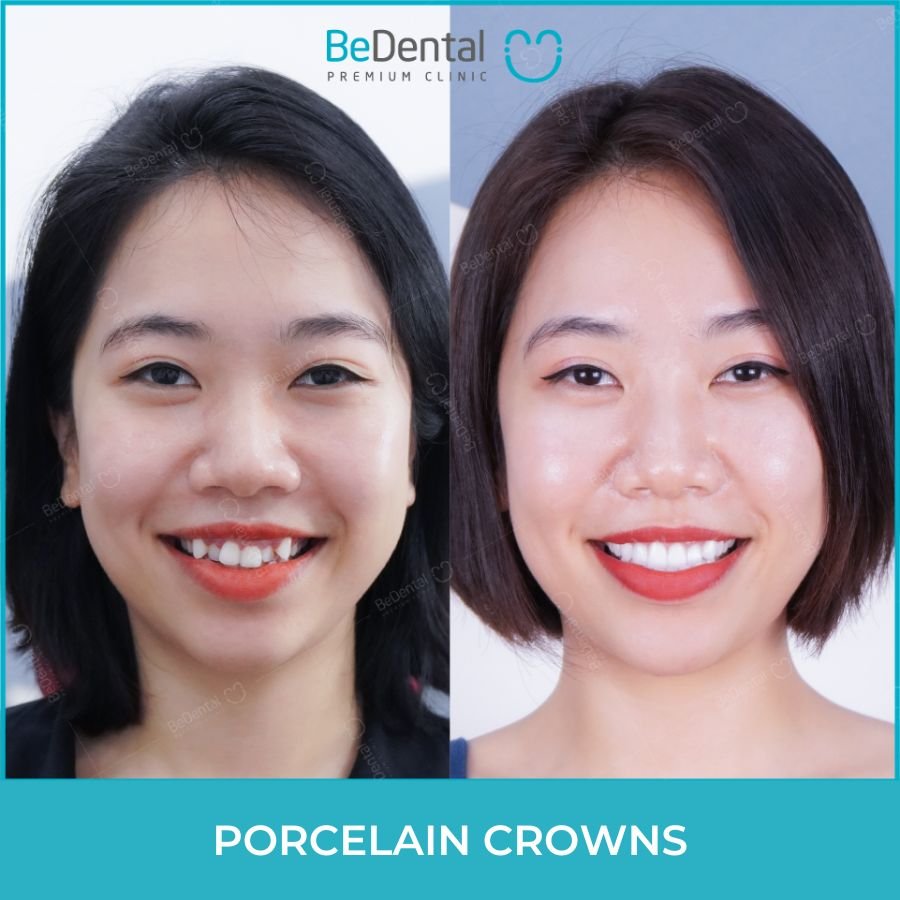

What problems can develop with a dental crown?
There are several issues that you might experience over time with your crown, including:
- Discomfort or sensitivity: A newly-crowned tooth may be discomfort right away after the process as the anesthesia starts to take off. You can suffer from some heat and cold sensitivity, If the crowned tooth still has a nerve inside. Your dentist may advise that you use toothpaste made for sensitive teeth. You can be in pain when you bite down, which means the crown is likely too high on the tooth. If this is the case, call your dentist. This problem is simple to resolve.
- Chipped crown: All porcelain crowns can sometimes chip. The crown can be kept in your mouth after repairing minor chips. The dental crown may need to be replaced if the chip is large or when there are many chips.
- Loose crown: Sometimes, the cement that holds the crown on can be removed from beneath the crown. This not only makes it possible for the crown to come away but also makes it possible for germs to enter and attack the remaining tooth. If your crown feels loose, contact your dentist’s office.
See more: At-Home Teeth Whitening Kits
- Crown falls off: It’s possible for a dental crown to come off. When this occurs, it’s typically because of a bad fit or a shortage of cement. Get in touch with your dentist’s office right away if this occurs to you. Before you can schedule a visit, your dentist will give you detailed instructions on how to care for your tooth and crown. Your crown could be re-cemented in place by the dentist. If the crown cannot be repositioned, a new crown must be made.
- Allergic reaction: Dental crowns are often made of a combination of different metals. You can have an allergic reaction to the metal or porcelain that’s used in the dental crown. However, this is quite uncommon.
- Dark line on crowned tooth next to the gum line: Your crowned tooth’s gum line may have a black line next to it. This is normal, especially if you have a porcelain-fused-to-metal crown. Actually, the metal of the crown is visible through this black line.
FAQs:
What are PFM crowns?
PFM crowns stand for “porcelain-fused-to-metal”, and combine the benefits of metal crowns (durability) with the advantages of porcelain crowns (aesthetic).
Is a porcelain crown treatment safe?
Porcelain crown construction is a safe technique, and the materials are all FDA-approved. There are still risks and complications during the procedure, but our highly trained professionals have a wealth of knowledge to handle any unexpected situations.
Will my dental insurance cover porcelain crown treatment?
It really depends on what is covered on your dental insurance, as all dental plans and insurance policies are different. However, at our clinic, you can receive a warranty car valuing from 7 to 30 years, depending on which type. In particular, for Cercon HT porcelain teeth you have an authentic 10-year warranty. Besides, you are free to choose your installment plan through credit cards from various banks such as Vietcombank, Sacombank, VPBank, HSBC,… The installment process is quick and very simple.
How long do dental crowns last?
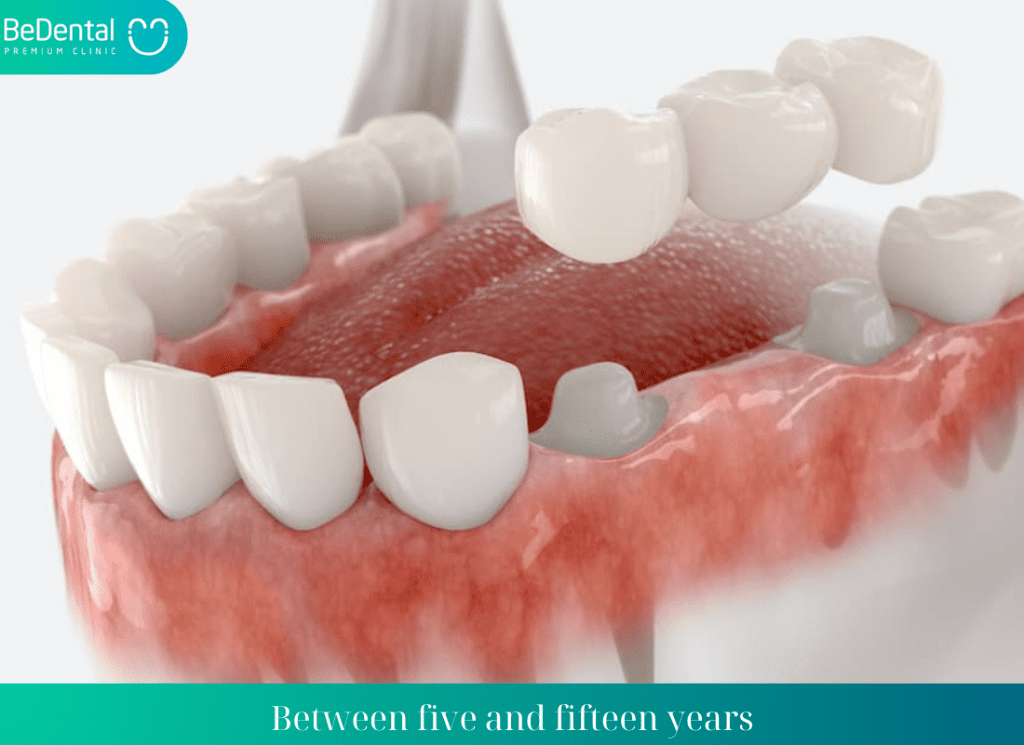
Between five and fifteen years is the typical lifespan of dental crowns. The amount of “water and tear” the crown is exposed to, how often you practice oral hygiene routine or your mouth-related habits can all affect how long it will last. These practices include:
- Grinding or clenching your teeth.
- Chewing ice.
- Biting your fingernails.
- Open packaging with your teeth.
How much do dental crowns in Hanoi cost?
Every treatment’s cost is fully based on your oral health and your needs. For instance, you can decide the size and shape of the crown you need. In some cases, you need more than a porcelain crown. The prices for porcelain crowns at BeDental are available on our page here.
Porcelain crowns, for example, are more expensive than gold crowns, which are normally more expensive than porcelain-fused-to-metal crowns. Dental crowns typically cost between 5.500.000 VND and 16.000.000 VND or more per. Most of the time, insurance doesn’t completely cover the expense of crowns. Consult your personal dental insurance provider to be sure.
See more: Ceramic braces
Are there any common problems that come from porcelain crowns?
Porcelain crowns can last around 5 to 20 years under any circumstance. However, they are not as resistant as metal or PFM crowns, so it’s crucial to remember to protect your dental crown. You only need to maintain a basic dental hygiene routine to take care of your porcelain crown.
Porcelain crowns are designed to last anywhere from 5 to 20 years. However, they are not as durable as metal or PFM crowns, so it’s important to ensure you take care of your dental crown. Following a simple dental hygiene routine is all that’s required when taking care of your porcelain crown. This includes flossing, brushing and staying away from sweetened foods and beverages.
Does a crowned tooth require any special care?
A crowned tooth can be treated just like any other tooth.However, the underlying tooth needs to be protected from cavities or gingivitis. As a result, you should practice good oral hygiene every day. These practices include brushing your teeth twice a day, flossing once a day, and rinsing after a meal. In addition, eat less hard or cold food to prevent cracking the porcelain crown.
More
Tư vấn chuyên môn bài viết:
BÁC SĨ DƯƠNG THỊ THÙY NGA
BEDENTAL - TOP STANDARD DENTISTRY SYSTEM
In HANOI
Address 1: 7B Thi Sach St, Ngo Thi Nham, Hai Ba Trung Dist, Ha Noi. - 0934.61.9090
Address 2: 343 Tay Son St, Nga Tu So Ward, Dong Da Dist, Ha Noi. (Nga Tu So Cross) - 0934.61.9090
Address 3: CC2 Tower Nguyen Huu Tho St, Dinh Cong Ward, Hoang Mai Dist, Ha Noi. (Inside True Hope ) - 0934.61.9090
In HO CHI MINH
Address 1: 53 -55 -57 Pho Duc Chinh St, Nguyen Thai Binh, Dist. 1, Ho Chi Minh. - 0766.00.8080
Address2: 25, City Land urban area, Go Vap Dist, Ho Chi Minh - 0766.00.8080
Working: 9am - 6pm everyday
Website: https://bedental.vn/en/



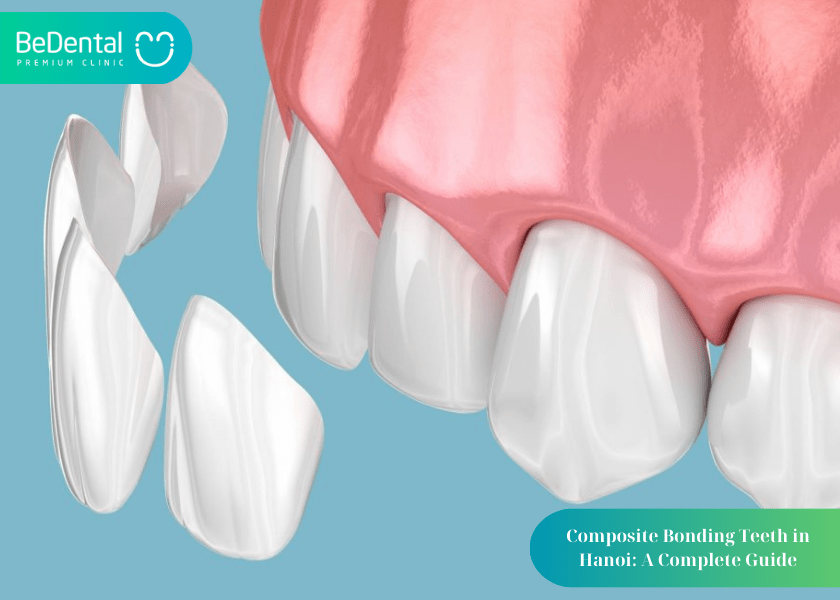

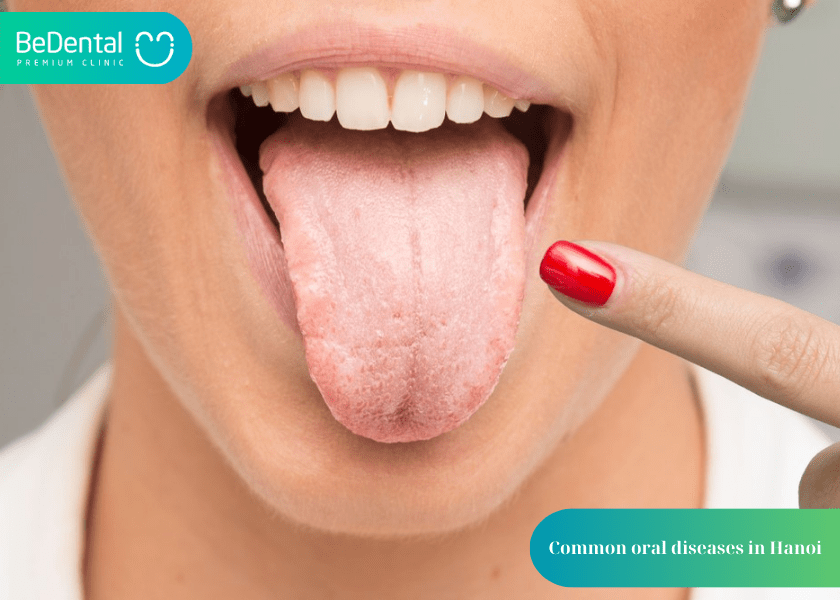
Pingback: Teeth fluorosis: 4+ things you must know – Be Dental
Pingback: Tooth Discoloration and 3 Types of Tooth Discoloration – Be Dental
Pingback: Zirconia crown and 7 common questions – Be Dental